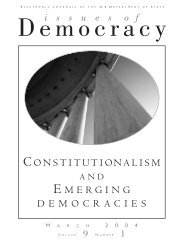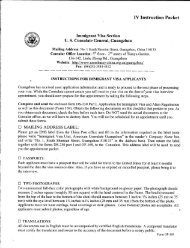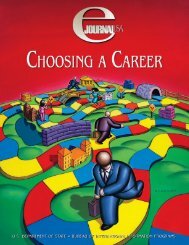s. history us history us history - Embassy of the United States
s. history us history us history - Embassy of the United States
s. history us history us history - Embassy of the United States
- No tags were found...
Create successful ePaper yourself
Turn your PDF publications into a flip-book with our unique Google optimized e-Paper software.
CHAPTER 9: DISCONTENT AND REFORMOUTLINE OF U.S. HISTORYprolific womb <strong>of</strong> governmentalinj<strong>us</strong>tice we breed <strong>the</strong> two greatclasses — tramps and millionaires.The pragmatic portion <strong>of</strong> <strong>the</strong>irplatform called for <strong>the</strong> nationalization<strong>of</strong> <strong>the</strong> railroads; a low tariff;loans secured by non-perishablecrops stored in government-ownedwareho<strong>us</strong>es; and, most explosively,currency inflation through Treasurypurchase and <strong>the</strong> unlimited coinage<strong>of</strong> silver at <strong>the</strong> “traditional” ratio<strong>of</strong> 16 ounces <strong>of</strong> silver to one ounce<strong>of</strong> gold.The Populists showed impressivestrength in <strong>the</strong> West and South, and<strong>the</strong>ir candidate for president polledmore than a million votes. But<strong>the</strong> currency question soon overshadowedall o<strong>the</strong>r issues. Agrarianspokesmen, convinced that <strong>the</strong>irtroubles stemmed from a shortage<strong>of</strong> money in circulation, argued thatincreasing <strong>the</strong> volume <strong>of</strong> moneywould indirectly raise prices forfarm products and drive up ind<strong>us</strong>trialwages, th<strong>us</strong> allowing debts to bepaid with inflated currency. Conservativegroups and <strong>the</strong> financial classes,on <strong>the</strong> o<strong>the</strong>r hand, respondedthat <strong>the</strong> 16:1 price ratio was nearlytwice <strong>the</strong> market price for silver. Apolicy <strong>of</strong> unlimited purchase woulddenude <strong>the</strong> U.S. Treasury <strong>of</strong> all itsgold holdings, sharply devalue <strong>the</strong>dollar, and destroy <strong>the</strong> purchasingpower <strong>of</strong> <strong>the</strong> working and middleclasses. Only <strong>the</strong> gold standard, <strong>the</strong>ysaid, <strong>of</strong>fered stability.The financial panic <strong>of</strong> 1893heightened <strong>the</strong> tension <strong>of</strong> this debate.Bank failures abounded in <strong>the</strong>South and Midwest; unemploymentsoared and crop prices fell badly.The crisis and President GroverCleveland’s defense <strong>of</strong> <strong>the</strong> gold standardsharply divided <strong>the</strong> DemocraticParty. Democrats who were silversupporters went over to <strong>the</strong> Populistsas <strong>the</strong> presidential elections <strong>of</strong>1896 neared.The Democratic convention thatyear was swayed by one <strong>of</strong> <strong>the</strong> mostfamo<strong>us</strong> speeches in U.S. political<strong>history</strong>. Pleading with <strong>the</strong> conventionnot to “crucify mankind ona cross <strong>of</strong> gold,” William JenningsBryan, <strong>the</strong> young Nebraskan champion<strong>of</strong> silver, won <strong>the</strong> Democrats’presidential nomination. The Populistsalso endorsed Bryan.In <strong>the</strong> epic contest that followed,Bryan carried almost all <strong>the</strong> Sou<strong>the</strong>rnand Western states. But he lost<strong>the</strong> more populated, ind<strong>us</strong>trialNorth and East — and <strong>the</strong> election— to Republican candidate WilliamMcKinley.The following year <strong>the</strong> country’sfinances began to improve, in partowing to <strong>the</strong> discovery <strong>of</strong> gold inAlaska and <strong>the</strong> Yukon. This provideda basis for a conservativeexpansion <strong>of</strong> <strong>the</strong> money supply. In1898 <strong>the</strong> Spanish-American Wardrew <strong>the</strong> nation’s attention fur<strong>the</strong>rfrom Populist issues. Populism and<strong>the</strong> silver issue were dead. Many <strong>of</strong><strong>the</strong> movement’s o<strong>the</strong>r reform ideas,however, lived on.THE STRUGGLES OF LABORThe life <strong>of</strong> a 19th-century Americanind<strong>us</strong>trial worker was hard.Even in good times wages were low,hours long, and working conditionshazardo<strong>us</strong>. Little <strong>of</strong> <strong>the</strong> wealth that<strong>the</strong> growth <strong>of</strong> <strong>the</strong> nation had generatedwent to its workers. Moreover,women and children made up a highpercentage <strong>of</strong> <strong>the</strong> work force in someind<strong>us</strong>tries and <strong>of</strong>ten received but afraction <strong>of</strong> <strong>the</strong> wages a man couldearn. Periodic economic crises swept<strong>the</strong> nation, fur<strong>the</strong>r eroding ind<strong>us</strong>trialwages and producing high levels <strong>of</strong>unemployment.At <strong>the</strong> same time, technologicalimprovements, which added somuch to <strong>the</strong> nation’s productivity,continually reduced <strong>the</strong> demand forskilled labor. Yet <strong>the</strong> unskilled laborpool was constantly growing, as unprecedentednumbers <strong>of</strong> immigrants— 18 million between 1880 and1910 — entered <strong>the</strong> country, eagerfor work.Before 1874, when Massach<strong>us</strong>ettspassed <strong>the</strong> nation’s first legislationlimiting <strong>the</strong> number <strong>of</strong> hours womenand child factory workers couldperform to 10 hours a day, virtuallyno labor legislation existed in <strong>the</strong>country. It was not until <strong>the</strong> 1930sthat <strong>the</strong> federal government wouldbecome actively involved. Until<strong>the</strong>n, <strong>the</strong> field was left to <strong>the</strong> stateand local authorities, few <strong>of</strong> whomwere as responsive to <strong>the</strong> workers as<strong>the</strong>y were to wealthy ind<strong>us</strong>trialists.The laissez-faire capitalism thatdominated <strong>the</strong> second half <strong>of</strong> <strong>the</strong>19th century and fostered hugeconcentrations <strong>of</strong> wealth and powerwas backed by a judiciary that timeand again ruled against those whochallenged <strong>the</strong> system. In this, <strong>the</strong>ywere merely following <strong>the</strong> prevailingphilosophy <strong>of</strong> <strong>the</strong> times. Drawing ona simplified understanding <strong>of</strong> Darwinianscience, many social thinkersbelieved that both <strong>the</strong> growth<strong>of</strong> large b<strong>us</strong>iness at <strong>the</strong> expense <strong>of</strong>small enterprise and <strong>the</strong> wealth <strong>of</strong>a few alongside <strong>the</strong> poverty <strong>of</strong> manywas “survival <strong>of</strong> <strong>the</strong> fittest,” and anunavoidable by-product <strong>of</strong> progress.American workers, especially <strong>the</strong>skilled among <strong>the</strong>m, appear to havelived at least as well as <strong>the</strong>ir counterpartsin ind<strong>us</strong>trial Europe. Still,<strong>the</strong> social costs were high. As late as<strong>the</strong> year 1900, <strong>the</strong> <strong>United</strong> <strong>States</strong> had<strong>the</strong> highest job-related fatality rate<strong>of</strong> any ind<strong>us</strong>trialized nation in <strong>the</strong>world. Most ind<strong>us</strong>trial workers stillworked a 10-hour day (12 hours in<strong>the</strong> steel ind<strong>us</strong>try), yet earned lessthan <strong>the</strong> minimum deemed necessaryfor a decent life. The number <strong>of</strong>children in <strong>the</strong> work force doubledbetween 1870 and 1900.The first major effort to organizeworkers’ groups on a nationwidebasis appeared with <strong>the</strong> NobleOrder <strong>of</strong> <strong>the</strong> Knights <strong>of</strong> Labor in1869. Originally a secret, ritualisticsociety organized by Philadelphiagarment workers and advocating acooperative program, it was opento all workers, including AfricanAmericans, women, and farmers.The Knights grew slowly until itsrailway workers’ unit won a strike192193












